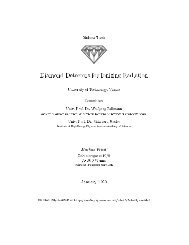Create successful ePaper yourself
Turn your PDF publications into a flip-book with our unique Google optimized e-Paper software.
voltage information and 2 bits specifiying the gain) for every 25 ns period. For theTrigger Primitive Generation (TPG), a sliding window of ten such samples aroundthe current bunch crossing is considered. The signals from 25 crystals are linearizedand summed to five strip sums before undergoing filtering and time deconvolution tosuppress noise and identify the originating bunch crossing. These strip sums are usedto provide a fine-grain veto bit on the result when the shower profile is not sufficientlyconcentrated in one strip to be compatible with an electron or photon. The sum of thefive strip energies and the fine-grain veto bit are forwarded to a trigger concentratorwhich serializes inputs from a number of trigger towers and sends them to the RegionalCalorimeter Trigger (RCT).4.1.2 HCAL Trigger Primitive GenerationHCAL TPG is similar in principle to the process for the ECAL. The output signalsfrom photodiodes are digitized to a pseudo-floating point format (5 bits of significantdigits and 2 bits of range). An intermediate processor linearizes these values, providesbunch crossing identification and sums the appropriate inputs for a trigger tower. Thefine-grain veto bit of the ECAL TPG is replaced by the minimum ionizing particle(MIP) bit which indicates that the energy deposit is compatible with the passage of amuon. The output to the RCT happens in the same format as for the ECAL.4.1.3 Regional Calorimeter TriggerThe Regional Calorimeter Trigger (RCT) consists of 19 electronics crates in the CMScounting room. 18 of these crates receive the E T values from the trigger towers in bothHCAL and ECAL, each crate covering one half of the detector in z and 40 ◦ in φ. Eachof these identifies the four highest-ranking isolated and non-isolated electron or photoncandidates in its region and sends them to the global calorimeter trigger. In addition,it coarse-grains the E T sums over 4 × 4 trigger tower regions, assigning MIP (if oneof the HCAL trigger towers produced a MIP bit), quiet (if the energy sum is below athreshold value) and τ veto (if the activity in the 4 × 4 region is not compatible witha τ jet) bits to each region. These are forwarded to the Global Calorimeter Trigger(GCT). The HF trigger regions are forwarded to the GCT without processing.4.1.4 Global Calorimeter TriggerThe Global Calorimeter Trigger (GCT) receives the e/γ information from the RCT andsorts them in two Leaf Cards. A Concentrator Card receives data from the two LeafCards and performs the final sorting. Only the overall four highest-ranked candidatesout of 36 regional candidates are selected and forwarded to the GT for each of theparticle categories output by the RCT. The calorimeter trigger also looks for clustersin the E T sums provided by the RCT and produces jet candidates from these. The fourcandidates with highest E T for forward jets (from high-|η| regions), τ jets (without aτ veto bit in their region) and central jets each are forwarded to the global trigger.38












